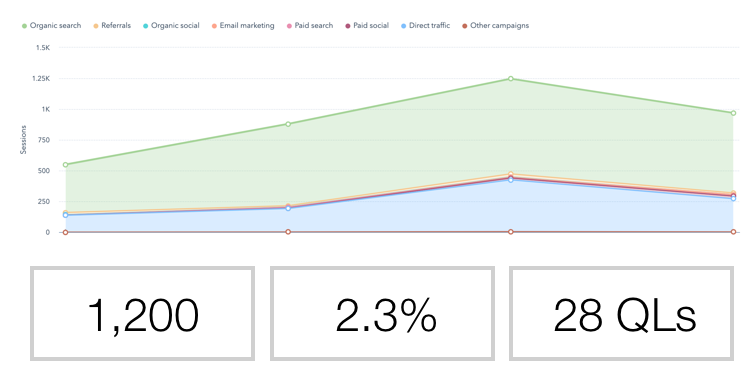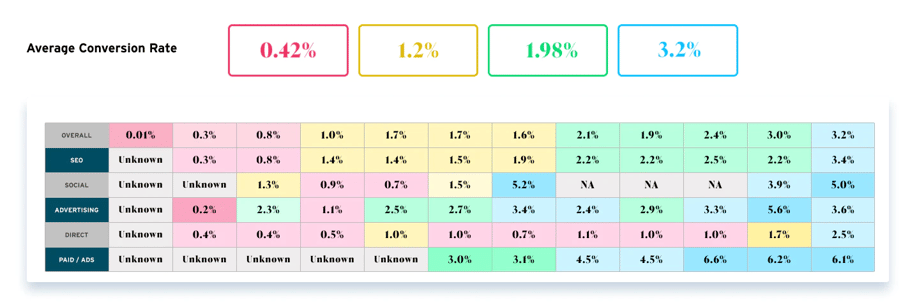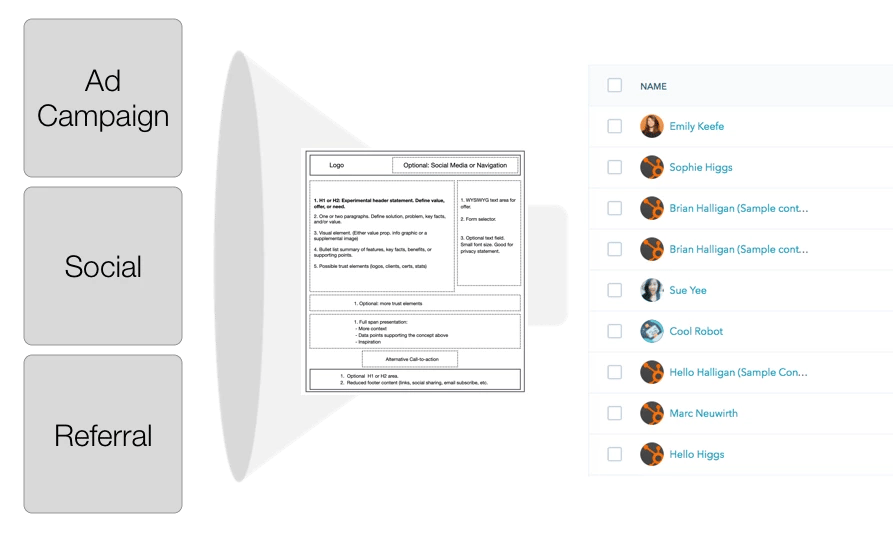
Often times, enterprises try to answer the question, What is a good conversion rate? without any context.
When establishing conversion rates, context is everything.

A lack of context can actually do harm to a marketing team because it causes teams to make the wrong assumptions. Then, they might accelerate when they should optimize, or vice versa.
Therefore, conversion rates viewed in a vacuum are useless. But you can set a conversion rate with informed data: Here are the critical steps to set a conversion rate goal, both for B2B lead generation and new customers (and everything in between).
Conversion rate is one of the most critical metrics for an enterprise's website. But only about 22% of businesses are satisfied with their conversion rates. – Econsultancy
Perhaps this is because CMOs have trouble identifying the right goal for a conversion rate in the first place. Many CMOs ask their teams to identify what their baseline conversion rate should be. They also ask what is the “industry standard.”
But while many organizations have tried to address this question, it's important to take conversion rate data in context and qualify your reasoning.
First and foremost, we stress the importance of always providing context when discussing conversion rates.
Industry benchmarks are a bad way to answer the question, “What is a good conversion rate?”
This is because industry benchmarks fail to answer the fundamental questions of a conversion goal: Which conversion are we measuring, and whom are we measuring?
 Conversion rates are subjective. You should base long-term goals off of business factors, not benchmarks.
Conversion rates are subjective. You should base long-term goals off of business factors, not benchmarks.
For example, does a benchmark “2-3% conversion rate” indicate that insignificant visitors submitted an email address to grab a quick freebie? Or that qualified B2B business leads converted on a bottom-of-funnel form?
A benchmark conversion rate looks good on paper as an enterprise’s target. But since it lacks context for what the conversion measures and whom it targets, it doesn’t help the company set meaningful objectives to grow.
A Wordstream report stated that 2.35% was an average conversion rate for PPC campaigns based on three months of data from a company. (“Everything You Know About Conversion Rate Optimization Is Wrong.”)
There was no standard of quality established in the article for these conversions. This meant that a blog subscriber receiving a free coupon for a low-cost email service was considered to have the same valuation as a CIO with a strong buying intent for a multi-million dollar IT purchase.
Data qualification standards matter: Otherwise, you’re comparing Little League batters to Major League Baseball players and trying to set an overall batting average.
Peter Meyers addresses it well:
Whenever people talk about conversion rates, they all seem to quote an average of 2-3%. The problem is that, over time, I've noticed another phenomenon: No one ever seems to back this up with data. Ultimately, 2-3% conversion seems to be a bit like Bigfoot or, at best, a friend-of-a-friend statistic: ‘my cousin's sister's hairdresser said she read in Business Week that the average website gets 2-3% conversion.' – Peter Meyers
In order to determine a good conversion rate, you first need to answer the two main conversion questions: What is a conversion and its value, and whom are we converting?
 Typical pathway for a top-of-funnel conversion, traffic-to-lead. Although, not the only conversion to measure.
Typical pathway for a top-of-funnel conversion, traffic-to-lead. Although, not the only conversion to measure.
Above all, a conversion should be a measurable action that you can distinguish on an individual level. For example, you should be able to discern if one person filled out the same form twice, or if two people filled it out once.
Keep in mind that each of these conversions has a different value for business. An SQL conversion is far more valuable than a new newsletter signup.
The Google method for determining conversion value is this: What % of people at that stage in the buying process does your sales team close into customers? Then, what is the average LTV of closing that prospect into a customer?
For example: Say 10% of people who are SQLs close into customers. The value of a customer is $10,000. Therefore, the value of an SQL conversion is $10,000 × 10% = $1,000.
Additionally, you should have a clear criteria for whom you’re converting.
 Someone who fits your target persona might carry more value for the conversion you're measuring. That's why understanding your personas (especially profitable ones) is key.
Someone who fits your target persona might carry more value for the conversion you're measuring. That's why understanding your personas (especially profitable ones) is key.
Will you count anyone who takes the action, or will you tease out only qualified business leads? Since you may have a high number of competitors or spammers who can muddle with your conversion rate — Do you have a method to identify valid leads, like a marketing automation tool?
Once you've determined who counts towards a conversion goal, you’ll have a clearer business value to assign that conversion.
For example, if anyone who submits an email address for a newsletter subscription, the conversion value could be $2. But for MQL>SQL conversions for which you set a high bar of "quality" leads, the value could be $2,000.
The value of a conversion determines a “good” conversion rate, and will tell you how many of that particular conversion you need to set goals. Remember that value generally increases down the funnel.
To determine an informed conversion rate for your business, first you need to work through obstacles that can skew your insights.
By answering these questions, you pave a pathway to contextual relevancy:
After determining these answers, you can follow best practices to set a contextual conversion rate goal that works for your B2B company.
As a marketing strategist for a B2B company, take a stake in your business’ top line. When you ask the question, "What is a good conversion rate?" don’t set your marketing goals to reach an insignificant goal. Instead, make decisions that benefit your sales team and close deals with better, vetted leads.
Although many CMOs and executives make critical decisions about marketing efforts by citing industry standard data reports, remember this:
Not all conversions have the same value, ease of acquisition, or barriers of access.
If marketers purely try to drive for higher and higher conversion rates, then the business results may suffer.
by Jonathan Franchell, CEO of Ironpaper - For more tips and hacks: Need to remove a new line after h1 tags? Both web designers and SEO practitioners need to employ headline tags: H1, H2, H3 in several ways to improve web page structure and tag...

The Crowded Arena of the IT Marketplace Updated December 2024 The Information Technology (IT) landscape is experiencing rapid growth and intensifying competition. IT spending is projected to reach nearly 5.1 trillion U.S. dollars in 2024, a...

The marketing industry is transforming significantly due to generative AI and increasing market complexity. Gartner's prediction of a 25% decline in traditional search traffic suggests that the era of search engines is dying. AI tools, particularly...

Updated December, 2024 The field of digital marketing is evolving rapidly in response to new technology and changing buyer expectations. To help career-minded marketers, we’ve rounded up the top 10 skills needed to succeed in the field. These are...
